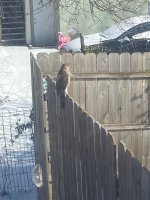Hainan on the fly
Well-known member
I have a really difficult time with similar looking hawks. I think my choices are either Cooper's or sharp-shined here with Cooper's being more geographically common. Any advice on separation criteria on these hawks would be greatly appreciated.
Thanks,
Brian
edit: New higher resolution picture added after first comment from Butty. Sorry for the confusion this added to the thread. I'd made the edit in seconds and didn't realize it had any views at that point.
Thanks,
Brian
edit: New higher resolution picture added after first comment from Butty. Sorry for the confusion this added to the thread. I'd made the edit in seconds and didn't realize it had any views at that point.
Attachments
Last edited:





